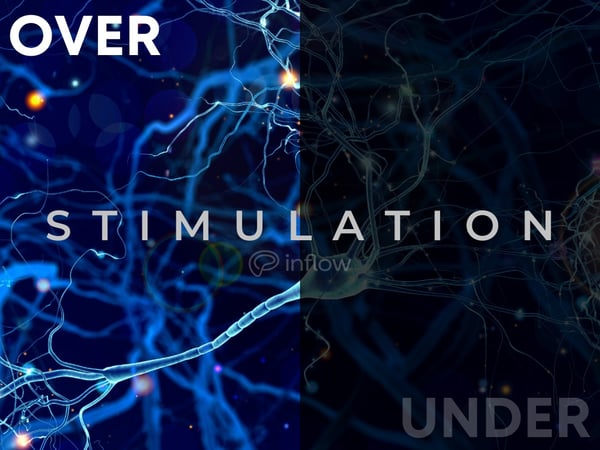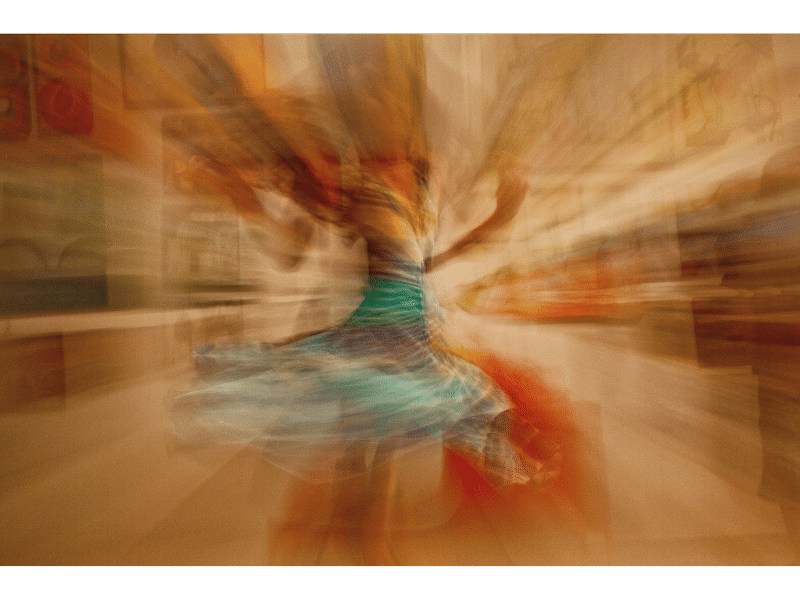Many adults with ADHD spend their lives bouncing between burnout and boredom, and it feels a bit like the fairy tale, Goldilocks and the Three Bears. No matter how hard we try to figure out what's “just right” for us, we still struggle to find the right balance.
A lot of this comes down to the way we experience stimulation; more specifically, it's connected to the ADHD brain's increased risk of experiencing both overstimulation and understimulation. Before diving into coping mechanisms, let's explore both ends of the sensory processing spectrum.
Too long; didn't read
- Overstimulation and understimulation are on opposite ends of the 'sensory processing spectrum'.
- Overstimulation causes hypervigilance and feelings of overwhelm.
- Understimulation often occurs due to boredom
- People with ADHD have a dopamine deficiency, which may affect sensory processing
What is ADHD overstimulation?
Overstimulation is a type of sensory overload. It explains those times when your brain 'takes in too much at once'. Here's an example you may be able to relate to:
Imagine you’re getting your weekly shopping done at the supermarket. There’s loud music playing, and every time you look down at your phone to check your list, somebody bumps into you with their shopping cart. There’s endless varieties for all of the items on your list, so you're forced to make mini-decisions for each one.
Eventually, feelings of overwhelm start to creep up, and you can almost feel your brain overheating - like an old laptop with too many tabs open.
That’s overstimulation.
What does ADHD overstimulation feel like?
ADHDers have lots of different ways of describing this feeling:
- “fried”
- "like my brain is full of static”
- “hot and angry”
- "bees in my head"
- "like my head is too full"
But ultimately, these variations all generally refer to the feeling where your brain just can’t take any more. Any overwhelming situation — conflict, rumination, being pressured to make decisions, receiving an influx of new information — has the potential to be overstimulating.
Signs you might be overstimulated
Everybody has a threshold for how much input they can handle, and anyone can experience overstimulation — ADHD or not. However, because people with ADHD struggle to filter out competing stimuli, overstimulation is especially common for neurodiverse brains. Something as simple as someone tapping their pencil during an exam might be enough to distract and overstimulate us.
This is especially true for those of us ADHDers who are also autistic, as a hallmark autistic trait is struggling with sensory processing.
Signs and symptoms of overstimulation in adults:
- You’re irritable and snappy with others.
- You feel strung-out and oversensitive; on the verge of tears or an angry outburst.
- The world feels like it's “too much” to cope with.
- You feel anxious and unable to string thoughts together, like you can’t get your brain to focus on tasks or understand what’s required of you.
- You have the urge to remove sensory inputs (i.e. covering your ears, using noise-cancelling headphones, removing tight clothing, or going somewhere to be alone).
At best, overstimulation can make us irritable, tired, and unable to focus.
At worst — especially when we can’t escape the overstimulating stimuli — it can cause disassociation and extreme emotions. If you regularly experience overwhelm from stimuli, it might be worth looking into the autistic experience of “meltdowns”.
How to cope with overstimulation
Luckily, there are simple techniques that can help minimize overstimulation.
1. Check in with yourself.
- What’s causing these feelings?
- Is it something solvable? (e.g. turning off the music so you can focus, or putting on the air conditioning so you’re more comfortable)
If your overwhelm is coming from an emotion or a task, take 5 minutes to regroup before pushing forward.
2. Learn your common triggers and work to make them less problematic.
For example, if you notice you’re consistently getting distracted and frustrated at work because of adjacent coworker conversations, invest in a pair of noise-cancelling headphones.
Or - if you have a friend who is emotionally overwhelming, try to catch up with them on days where you don’t have much else going on.
3. Embrace relaxation and recovery.
You can’t brute force your way out of overstimulation. You’ll only start to feel better after you let your brain rest and “cool down”.
Resting doesn't have to mean sleeping or doing nothing, either. Try engaging in an activity that you enjoy and find relaxing, like swimming or playing video games. Give yourself permission to unwind until your brain starts to feel "normal" again.
ADHD understimulation
Understimulation refers to those times when your brain isn't receiving enough sensory input to keep you engaged with your surroundings. Research suggests that people with ADHD produce less dopamine from positive stimulation than neurotypicals1, which can lead to feeling understimulated in situations that others are typically comfortable in.
What does ADHD understimulation feel like?
Some signs that you might be understimulated include:
- Lack of motivation
- Physical hyperactivity
- A sense of unease, making you feel "flat" or irritable
- Extreme impatience
- Dissociation or getting lost in daydreams
- Confrontational and argumentative behaviors
- Nail-biting, hair-pulling, skin-picking (all of which are body-focused repetitive behaviors or BFRBs), fidgeting, or compulsive snacking
- Exhaustion
If you’re reading this and thinking, “well, yeah — isn’t that just part of ADHD?” In some ways, yes.
But! A key difference between people with ADHD and neurotypicals? ADHDers need a lot more positive stimulation to feel engaged.
ADHD and feeling understimulated
Some of the hallmark signs of ADHD are more likely to manifest when we’re feeling understimulated. That’s why when we slip into hyperfocus — which can be really stimulating in a positive way — we’re not as easily distracted, and can often work for long periods of time.
Understimulation is typically less intense than overstimulation, but can be just as (if not more) troubling. Being understimulated makes it hard for ADHDers to be present in our day-to-day lives, and it can hinder our ability to carry out responsibilities.
How to deal with understimulation
Overcoming understimulation can be difficult, but there is a way to simplify it - add more positive stimulation! Here are some ideas:
- Do something with your hands in boring situations, like doodling or using a fidget spinner.
- Listen to music or ADHD podcasts while carrying out mundane tasks.
- Embrace physical movement rather than trying to stay still.
- If possible, engage in something you really enjoy for 5-10 minutes to wake your brain before entering understimulating environments.
- Try body-doubling, where another person keeps you company (physically or virtually) while you work.
- Find a way to make experiences new or exciting, such as changing your physical surroundings or trying new techniques to complete tasks.
- Set time limits for activities in order to create a 'false sense of urgency'.
Finding the right level of stimulation for different tasks is vital for dealing with task inertia and avoiding procrastination. If you’re experiencing general understimulation (rather than it being a related to a specific task or stimulus), try including enjoyable activities in your routine.
💡Pro Tip! "Enjoyable activities" should be something that requires active engagement, like visiting with a friend or dancing to music, rather than something you can passively absorb without thinking - such as scrolling through social media.
This is obviously easier said than done, but even taking five minutes to do something fun and engaging can drastically reduce feelings of understimulation.
Final thoughts
ADHD can make you feel like you’re Goldilocks — endlessly searching for stimuli that aren’t too much... but also aren’t too little. Take the time to check in with yourself about what might be causing you to feel overstimulated or understimulated.
You might just find a way to navigate your life in a way that feels just right.








